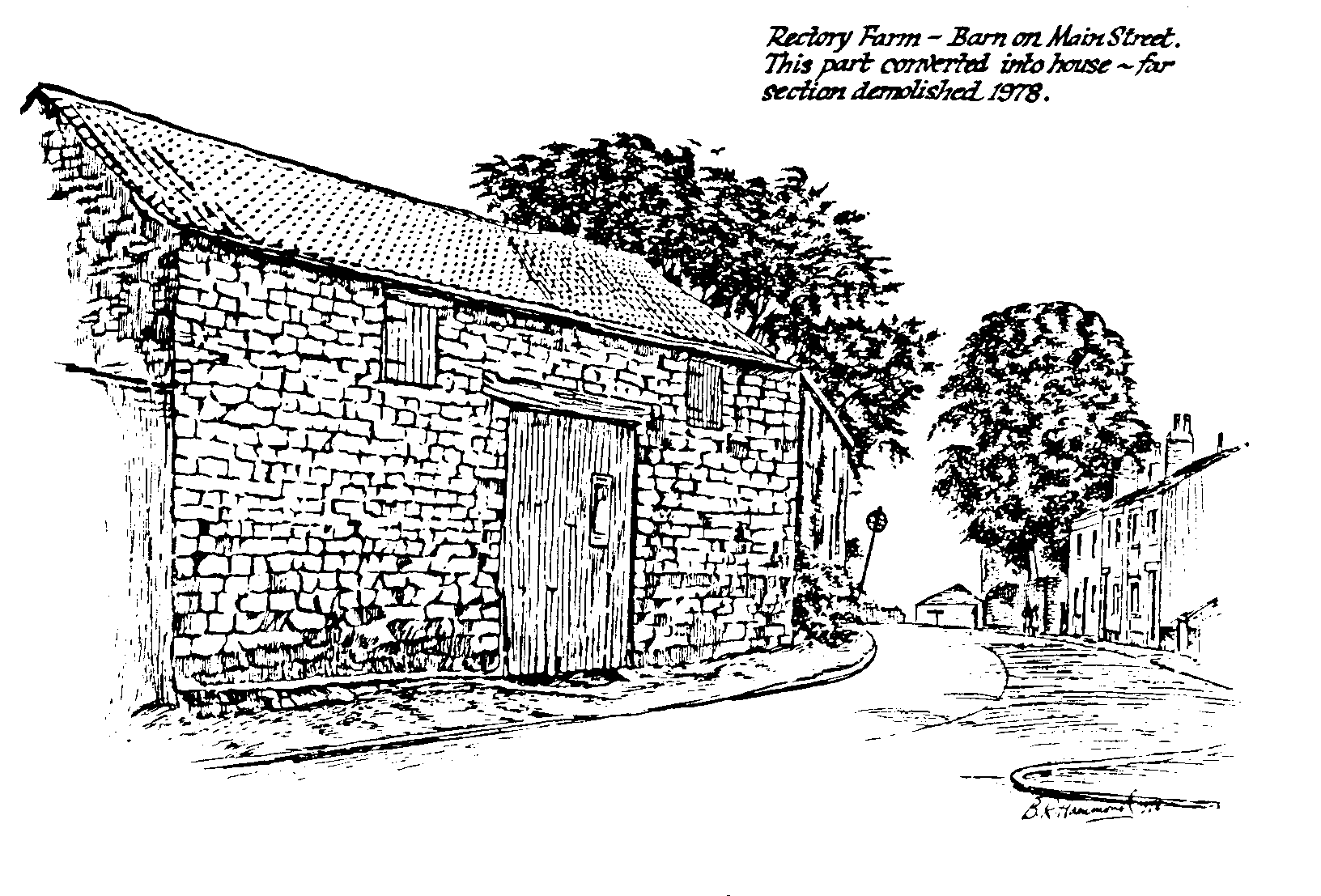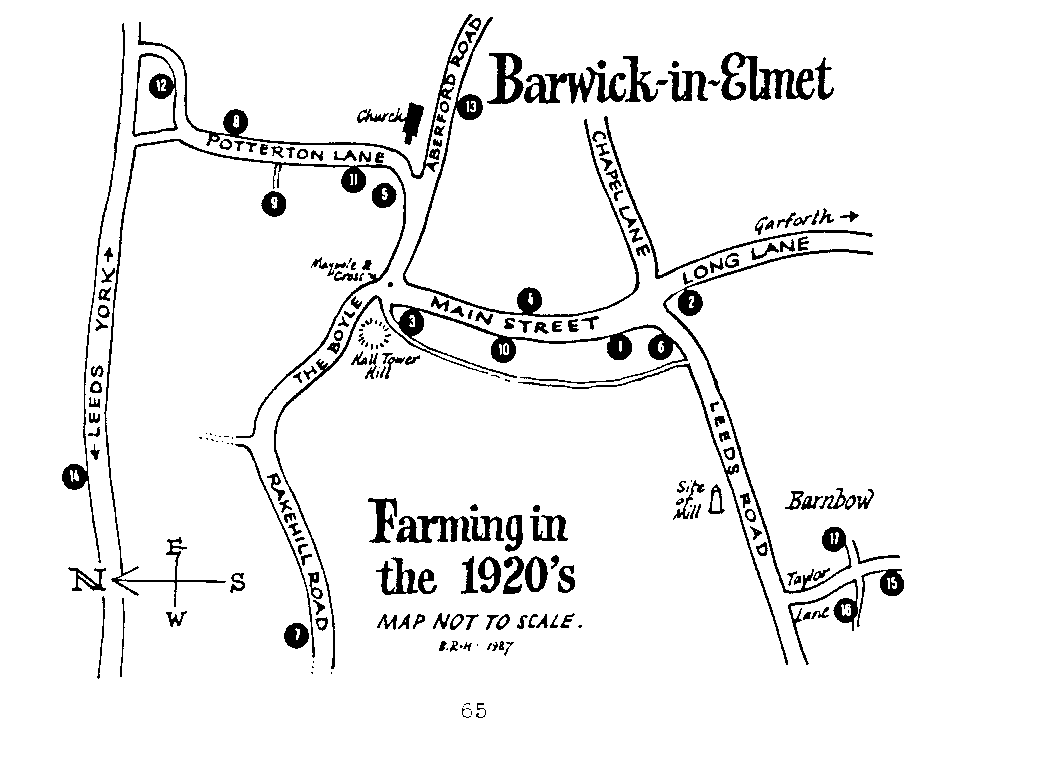Farming in Barwick In the 1920's
Back to the Main Historical Society page
Back to the Barwicker Contents page
Farming in Barwick In the 1920's
Barwicker
December 1987
This has been compiled from notes written by Bill Stead from his
memories of local farming in his young days 60 years ago. Stretching
beyond that are references to both his father and grandfather (born in
1861) who spent their whole working lives as local farm workers. Bill's
own comments on the farms in his day are as follows: (The numbers refer
to their map positions.)
1. Lime Tree Farm, Main Street. Thorps.
Mr. John Thorp and sons Fred and Percy had very large holdings of land
on the south-west side of Barwick, along Long Lane to Garforth Golf
Course. It was good, mixed land; corn grew well, as did root crops.
Cattle seemed to thrive on the grass pastures.
As a schoolboy I used to go at 3.30 after school hours into the
fields at harvest and hay times where it was being gathered by John
Thorp. He told Fred to go home and get the milking done, while we
started to load the corn on carts and wagons. Seven teams were going at
the same time, (no slacking!) and we kept this up until eight o'clock at
night, with just a tea break for ham sandwiches and tea or pop.
Enjoyable, but really tired at night. The helpers were all good men,
and at potato gathering he had some,good women for picking the crop.
They got three shillings and sixpence per day, and a bucket of potatoes
to take home.
This was a busy farm all the year round, with hedge-cutting and
ditches to clear. My father, Tom Stead, used to get all the hedges to
trim when they were getting out of hand. He made his own stakes for the
hedges, and saved hazel cuts for thatching use. Thorp's stack-yard when
finished looked smart with the stacks thatched and clipped to the inch.
A really good farm to work for in those days!
In winter Mr. Thorp went to the market at Whitkirk and bought about
twenty bullocks for wintering in the big fold-yard. They also kept pigs
amongst them. We used to slice turnips morning and night, and provide
bales of straw to keep the animals dry underfoot. This was a covered
fold-yard and dry; the buildings were old, but thick walls kept horses
and cows fairly warm. All their fodder was near to hand.
The farm was run by John Thorp and his two sons, with one horseman
and two apprentice boys; also plenty of casual labour, like my father,
all the year round.
2. Glebe Farm, Main St./ Lonq Lane. Mr. Mallinson later Gilpin.
This farm also stretched to Garforth Golf Course with land on either
side of Long Lane; good arable land with mixed paddocks for cattle. He
kept about thirty milking beasts, also six horses, pigs, etc.
Mr. Mallinson had one son, one horseman (Tim Joynes) and grandfather
Stead was cowman, plus several casual workers. Father, as usual did the
hedge cutting, thatching and other tasks that required his attention.
This was a farm that had not many buildings. The farmhouse at the
end of Long Lane faced down Main Street; attached was a long mistal and
a medium-sized stable for horses. Otherwise there were few buildings
for such a large farm, growing good corn crops and vegetables, with
ample fodder for winter feed.
The lady of the farm made butter and curds; my reward for turning the
old churn was often a big pot of curds for my mother's tarts. Mr.Gilpin
always asked my father to select his own goose for our Christmas dinner.
Mr.Mallinson left because his son did not care for farming and sold
out to the Gilpins of Roundhay Park, who employed a student, Billy
Mason,to look after it for them.
3. Gascoigne Farm, Main Street. Richard and Mark Helm
This farm at the maypole end of Main Street was in two parts. One at
the pub end stabled horses, wagons and so on, but part two was about a
hundred yards up the street, and comprised a good stack-yard, a
fold-yard for cattle and a milking shed for twenty cows. There were
pigs and fowls too.
The land stretched out westwards up to the old mill yard and
beyond, right across to Rakehill Road. Plentiful harvests of corn,
potatoes, turnips and greens provided a good potential for keeping the
cattle through the winter.
Mr.Mark Helm had Tom Braithwaite as his main man until he retired, but
there was always casual labour to be had. A very good farm and a good
farmer too! The buildings were not up to standard but served the
purpose. Women and children would be welcomed for potato harvesting.
On Saturday mornings about forty children would turn out.
Note. At the home end of the farm, they had a big dutch barn in
which were kept the wagonettes for Mr.Reed's twice weekly service to
Leeds (fare one shilling). These stayed in use until the first motor
buses appeared.

4. Rectory Farm, Main Street. Mr. Sykes
situated in the centre of Main Street were just the farm buildings, as
all the land was away in various places, some down Long Lane nearly at
Parlington, a field or two in Flats Lane and Chapel Lane. Good corn and
other crops, but not much livestock and not a very good farm! It was
run by Mr. Sykes, his son Archie and two or three casual workers.
5. Church Farm. Algie Robshaw
This was situated opposite the church at the end of Potterton Lane, with
the farmhouse on the roadside and a group of cottages at the side. A
fairly big farm with land ranging down Potterton Lane, around the church
and down Aberford Road! Other land beyond the mill yard, well spread
about, provided large crops of corn, turnips and other vegetables. The
farm buildings were a long drawn-out affair, but he only kept a few
cattle, pigs, fowls etc. There was a small paddock at the end of the
farm-yard. A few casual workers were employed. Not a very good farm!
6. Top of Main Street. William Howard and Son.
A small farm with land in scattered fields, with a few small buildings,
but it possessed a useful yard. Casual labour helped with the farm and
other crops, which were good. There were very few cattle. Mr. Howard
and his son ran the farm.
7. Rakehill Farm, Rakehill Road
This was a fairly big farm with all round, compact land, an excellent
square farmhouse with good farm buildings, with a long stable, cow shed
and pig pens. Two or three men were employed, besides casual labour, in
reasonable working conditions. It grew mixed crops with fodder all year
round, just outside the farm-yard and handy for cattle.
8. Potterton Grange Farm. Potterton Lane. Dransfield & Sons
This was towards Morgan Cross, on the right side of the lane with land
stretching from the beck at the bottom up to Potterton Hall and nearly
to Aberford. It was solid, hard land to work giving fair crops, with a
few cattle. The buildings were compact but not very big. Mr.Dransfield
and two sons ran the farm with occasional seasonal help.
9. Syke House Farm, Potterton Lane. Mr. Clayton
A compact little spot, but not a lot of acres! He used to drive his
threshing machine himself about the farm. For ploughing he was the only
one round here who used two threshing machines to plough with one at
either end propelled by wire rope back and forth. There was some rough
land which took some breaking up but yielded fair crops. Not many
cattle at this time, but he had a fine stud of Clydesdale stallions
which he travelled with. All labour here was casual.
10. Main Street (behind present butcher's shop). Mark Dobson
A small farmstead which occupied the centre of the village with access
front and rear from large gardens, with a good house and outbuildings,
Mark Dobson had a horse, cart and wagon. He used to fetch the miners'
coal from the pit-head when their allocation was due, charging four
shillings and sixpence to all the local pits. He carried out removals
and many other cartage jobs.
11. Potterton Lane. Fred Reed
This farm comprised some land down The Boyle and fields for grazing
horses. There was a smithy room for six or eight horses and several box
stalls. His main concern was his wagonette service to Leeds and a
number of other horse-drawn vehicles for local use and hire. Ed.(See "The
Days of Horse Transport in Barwick" by Jack Reed in "The Barwicker"
No.3.)
12. Brickpond Farm, Potterton. M. Green and Sons
This farm situated between Morgan Cross and Potterton Hall gates, was a
large farm with buildings in good shape, with plenty of room for horses,
cows, pigs and poultry, plus a good fold-yard for cattle. Some arable
land adjoined Potterton Hall estate, worked by the family plus labour
from the villages.
13. Low Farm, Aberford Road. W.Armitage and Son
A smallholding situated just below the old Pump Yard. It had a couple
of meadow fields for fodder. stock comprised a horse or two, with a
cart and wagon with good harness, also some poultry. With an orchard of
fruit trees nearby, it was an altogether neat, little place which they
helped to maintain by doing odd jobs around the village. There was no
arable land.
14. Kiddal Hall Farm. A64 Road
An extremely old farm on the Tadcaster Road about a mile from the Fox
and Grapes Inn. It was compact with good arable land and ample grazing
for cattle. There were about six horses and a similar number of cows,
besides young stock. With good crops and fodder, it was well farmed. I
recall in the early twenties, part of the Hall was taken down stone by
stone, numbered and sent back home by a wealthy American.
15. Upper Barnbow Farm, Barnbow. Adamsons
The farmhouse and buildings were on top of a steep hill just past
Barnbow Farm (No.16). With a generous spread of arable land and
pastures on the lower parts, stock was usually six horses, twelve cows,
pigs and poultry. A very well kept farm, mostly run by their own
labour!
16. Barnbow Farm (Honesty Farm). Foster and Sons
This was a smallholding, mixed, with a small number of cattle for their
own use, three horses, poultry and geese. It was run by a family with
eight children, all good helpers! Foster was what we call a night-soil
man, who looked after the sanitary arrangements for the council. The
boys helped in these tasks, nearly all at night owing to the nature of
the work of clearing out all outside toilets.
17. Carr Head Farm, Barnbow. Mr. White
A compact little farm near its Barnbow neighbours! The farm building
was square built with stables for eight horses, twelve cows and pigs in
various smaller buildings. Produce apart from useful hay and corn
crops, included rhubarb, cauliflower, cabbage, leeks, sprouts and
turnips for cattle. There were grass fields adjoining. The labour
employed was mostly casual, using Irish travellers etc. on their rounds.
These farms and smallholdings were in use up to the 1930's.
Everyone had some good use but many started to deteriorate in the early
thirties and they became run down as local labour went for other work in
building and more profitable jobs.
Bill Stead
Back to the top
Back to the Main Historical Society page
Back to the Barwicker Contents page


